Tensile and Tearing Properties of a Geocomposite Mechanically Damaged by Repeated Loading and Abrasion
Abstract
:1. Introduction
2. Materials and Methods
2.1. Testing Material
2.2. Work Plan
2.3. Degradation Tests
2.4. Tensile and Tearing Tests
3. Results and Discussion
3.1. Visual Analysis
3.2. Tensile Behaviour
3.2.1. Effect of Exposure Side on PET Filament Failure
- Tests on the Side with Filaments
- Tests on the Side without Filaments
3.2.2. PP Geotextile Failure vs. PET Filament Failure
3.2.3. Cross-Machine Direction vs. Machine Direction
3.3. Tearing Behaviour
3.3.1. Tests in the Machine Direction
3.3.2. Tests in the Cross-Machine Direction
3.4. Tearing Strength vs. Tensile Strength
3.5. Reduction Factors
4. Conclusions
- The degradation tests resulted in visible damage to the geocomposite (regardless of the direction or side tested), readily indicating that the reinforcement function was, in most cases, affected. The damage (type and severity) varied from test to test, anticipating different changes in the mechanical performance of the geocomposite.
- The degradation tests induced, in most cases, a deterioration in the tensile and tearing behaviour of the geocomposite.
- Regarding single tests, the reduction in tensile and tearing strength tended to be more relevant after RL tests than abrasion. The degradation induced to the geocomposite by the RL tests was relatively close, regardless of the direction or side tested.
- The double testing condition proved to be the most adverse scenario for the geocomposite, leading to the most considerable reductions in tensile and tearing strength.
- The deterioration of the tensile and tearing strength of the geocomposite depended, in some cases, on the direction tested. This was noticeable in degradation conditions that included exposure to abrasive actions.
- The tested side also influenced the degradation experienced by the geocomposite in abrasion tests. The differences were related to the structure of the geocomposite.
- An acceptable relationship was found between the decline in the tensile and tearing strength of the geocomposite. In most cases, the difference between the residual values of these two properties did not exceed 10% (in absolute values).
- With regard to reduction factors for tensile and tearing strength, the common method was, in most cases, not able to adequately quantify the combined effect of the RL and abrasion tests—the reduction factors calculated by using this method tended to be lower than those resulting from the double testing condition. The underestimation of the combined effect of degradation agents, ignoring possible interactions (synergisms) between them, may lead to incorrect designs.
Author Contributions
Funding

Institutional Review Board Statement
Informed Consent Statement
Data Availability Statement
Acknowledgments
Conflicts of Interest
Abbreviations and Notation
References
- Shukla, S.K.; Yin, J.-H. Fundamentals of Geosynthetic Engineering, 1st ed.; Taylor & Francis/Balkema: Leiden, The Netherlands, 2006. [Google Scholar]
- Koerner, R.M. Designing with Geosynthetics, 5th ed.; Pearson Education, Inc.: Upper Saddle River, NJ, USA, 2005. [Google Scholar]
- Greenwood, J.H.; Schroeder, H.F.; Voskamp, V. Durability of Geosynthetics, 2nd ed.; CRC Press: Boca Raton, FL, USA, 2016. [Google Scholar]
- ISO/TR 20432; Guidelines for the Determination of the Long-Term Strength of Geosynthetics for Soil Reinforcement. International Organization for Standardization: Geneva, Switzerland, 2007.
- WSDOT T925; Standard Practice for Determination of Long-Term Strength for Geosynthetic Reinforcement. Washington State Department of Transportation: Olympia, WT, USA, 2005.
- BS 8006-1; Code of Practice for Strengthened/Reinforced Soils and Other Fills. British Standards Institution: London, UK, 2010.
- EBGEO. Recommendations for Design and Analysis of Earth Structures Using Geosynthetic Reinforcements, 1st ed.; Deutsche Gesellschaft für Geotechnik (German Geotechnical Society): Munich, Germany, 2011. [Google Scholar]
- Allen, T.M.; Bathurst, R.J. Combined allowable strength reduction factor for geosynthetic creep and installation damage. Geosynth. Int. 1996, 3, 407–439. [Google Scholar] [CrossRef]
- Greenwood, J.H. The effect of installation damage on the long-term design strength of a reinforcing geosynthetic. Geosynth. Int. 2002, 9, 247–258. [Google Scholar] [CrossRef]
- Cho, S.D.; Lee, K.W.; Cazzuffi, D.A.; Jeon, H.Y. Evaluation of combination effects of installation damage and creep behavior on long-term design strength of geogrids. Polym. Test. 2006, 25, 819–828. [Google Scholar] [CrossRef]
- Carneiro, J.R.; Almeida, P.J.; Lopes, M.L. Laboratory evaluation of interactions in the degradation of a polypropylene geotextile in marine environments. Adv. Mater. Sci. Eng. 2018, 2018, 9182658. [Google Scholar] [CrossRef]
- Almeida, F.; Carlos, D.M.; Carneiro, J.R.; Lopes, M.L. Resistance of geosynthetics against the isolated and combined effect of mechanical damage under repeated loading and abrasion. Materials 2019, 12, 3558. [Google Scholar] [CrossRef] [PubMed]
- Carlos, D.M.; Almeida, F.; Carneiro, J.R.; Lopes, M.L. Influence of mechanical damage under repeated loading on the resistance of geogrids against abrasion. Materials 2021, 14, 3544. [Google Scholar] [CrossRef] [PubMed]
- Hufenus, R.; Rüegger, R.; Flum, D.; Sterba, I.J. Strength reduction factors due to installation damage of reinforcing geosynthetics. Geotext. Geomembr. 2005, 23, 401–424. [Google Scholar] [CrossRef]
- Lim, S.Y.; McCartney, J.S. Evaluation of effect of backfill particle size on installation damage reduction factors for geogrids. Geosynth. Int. 2013, 20, 62–72. [Google Scholar] [CrossRef]
- Fleury, M.P.; Santos, E.C.G.; da Silva, J.L.; Palmeira, E.M. Geogrid installation damage caused by recycled construction and demolition waste. Geosynth. Int. 2019, 26, 641–656. [Google Scholar] [CrossRef]
- Tschöke, D.O.; Vidal, D.M.; Carmo, C.A.T. Installation damage of a geogrid employed for stabilization in mining area. Int. J. Geosynth. Ground Eng. 2023, 9, 10. [Google Scholar] [CrossRef]
- Huang, C.-C.; Chiou, S.-L. Investigation of installation damage of some geogrids using laboratory tests. Geosynth. Int. 2006, 13, 23–35. [Google Scholar] [CrossRef]
- Huang, C.-C. Laboratory simulation of installation damage of a geogrid. Geosynth. Int. 2006, 13, 120–132. [Google Scholar] [CrossRef]
- Cheah, C.; Gallage, C.; Dawes, L.; Kendall, P. Measuring hydraulic properties of geotextiles after installation damage. Geotext. Geomembr. 2017, 45, 462–470. [Google Scholar] [CrossRef]
- García-Caruso, C.; Lapeña-Mañero, P.; Blanco-Fernández, E.; Vega-Zamanillo, Á.; Montenegro-Cooper, J.M. Laboratory assessment of water permeability loss of geotextiles due to their installation in pervious pavements. Water 2020, 12, 1473. [Google Scholar] [CrossRef]
- EN ISO 10722; Geosynthetics—Index Test Procedure for the Evaluation of Mechanical Damage under Repeated Loading—Damage Caused by Granular Material. European Committee for Standardization: Brussels, Belgium, 2007.
- EN ISO 13427; Geosynthetics—Abrasion Damage Simulation (Sliding Block Test). European Committee for Standardization: Brussels, Belgium, 2014.
- Carneiro, J.R.; Carvalho, F.; Almeida, F.; Lopes, M.L. Effect of mechanical damage under repeated loading and abrasion on the tensile behaviour of a reinforcement geocomposite. IOP Conf. Ser. Mater. Sci. Eng. 2022, 1260, 012008. [Google Scholar] [CrossRef]
- EN ISO 9864; Geosynthetics—Test Method for the Determination of Mass per Unit Area of Geotextiles and Geotextile-Related Products. European Committee for Standardization: Brussels, Belgium, 2005.
- EN ISO 9863-1; Geosynthetics—Determination of Thickness at Specified Pressures. Part 1: Single Layers. European Committee for Standardization: Brussels, Belgium, 2016.
- EN ISO 11058; Geotextiles and Geotextile-Related Products—Determination of Water Permeability Characteristics Normal to the Plane, without Load. European Committee for Standardization: Brussels, Belgium, 2019.
- EN ISO 12956; Geotextiles and Geotextile-Related Products—Determination of the Characteristic Opening Size. European Committee for Standardization: Brussels, Belgium, 2019.
- EN ISO 9862; Geosynthetics—Sampling and Preparation of Test-Specimens. European Committee for Standardization: Brussels, Belgium, 2005.
- EN 13249; Geotextiles and Geotextile-Related Products—Characteristics Required for Use in the Construction of Roads and Other Trafficked Areas (Excluding Railways and Asphalt Inclusion). European Committee for Standardization: Brussels, Belgium, 2016.
- EN 13250; Geotextiles and Geotextile-Related Products—Characteristics Required for Use in the Construction of Railways. European Committee for Standardization: Brussels, Belgium, 2016.
- EN ISO 12960; Geotextiles and Geotextile-Related Products—Screening Test Methods for Determining the Resistance to Acid and Alkaline Liquids. European Committee for Standardization: Brussels, Belgium, 2020.
- EN 12447; Geotextiles and Geotextile-Related Products—Screening Test Method for Determining the Resistance to Hydrolysis in Water. European Committee for Standardization: Brussels, Belgium, 2021.
- EN ISO 13438; Geosynthetics—Screening Test Method for Determining the Resistance of Geotextiles and Geotextile-Related Products to Oxidation. European Committee for Standardization: Brussels, Belgium, 2018.
- Carneiro, J.R.; Carlos, D.M.; Lopes, M.L. Laboratory degradation of a reinforcement PET-PP geocomposite under accelerated weathering conditions. Int. J. Geosynth. Ground Eng. 2021, 7, 71. [Google Scholar] [CrossRef]
- EN ISO 10319; Geosynthetics—Wide-Width Tensile Test. European Committee for Standardization: Brussels, Belgium, 2015.
- ASTM D4533; Standard Test Method for Trapezoid Tearing Strength of Geotextiles. American Society for Testing and Materials International: West Conshohocken, PA, USA, 2002.
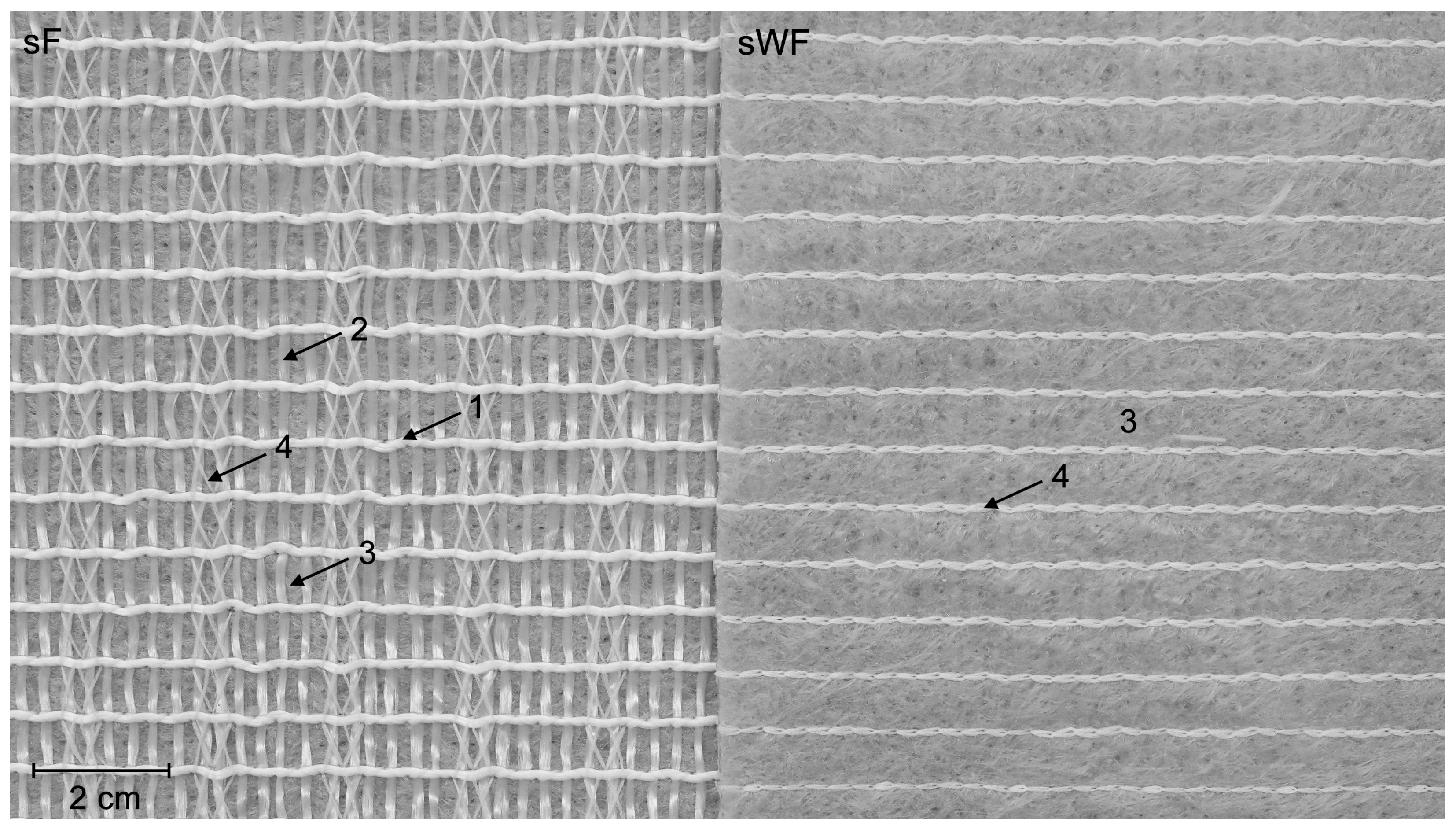
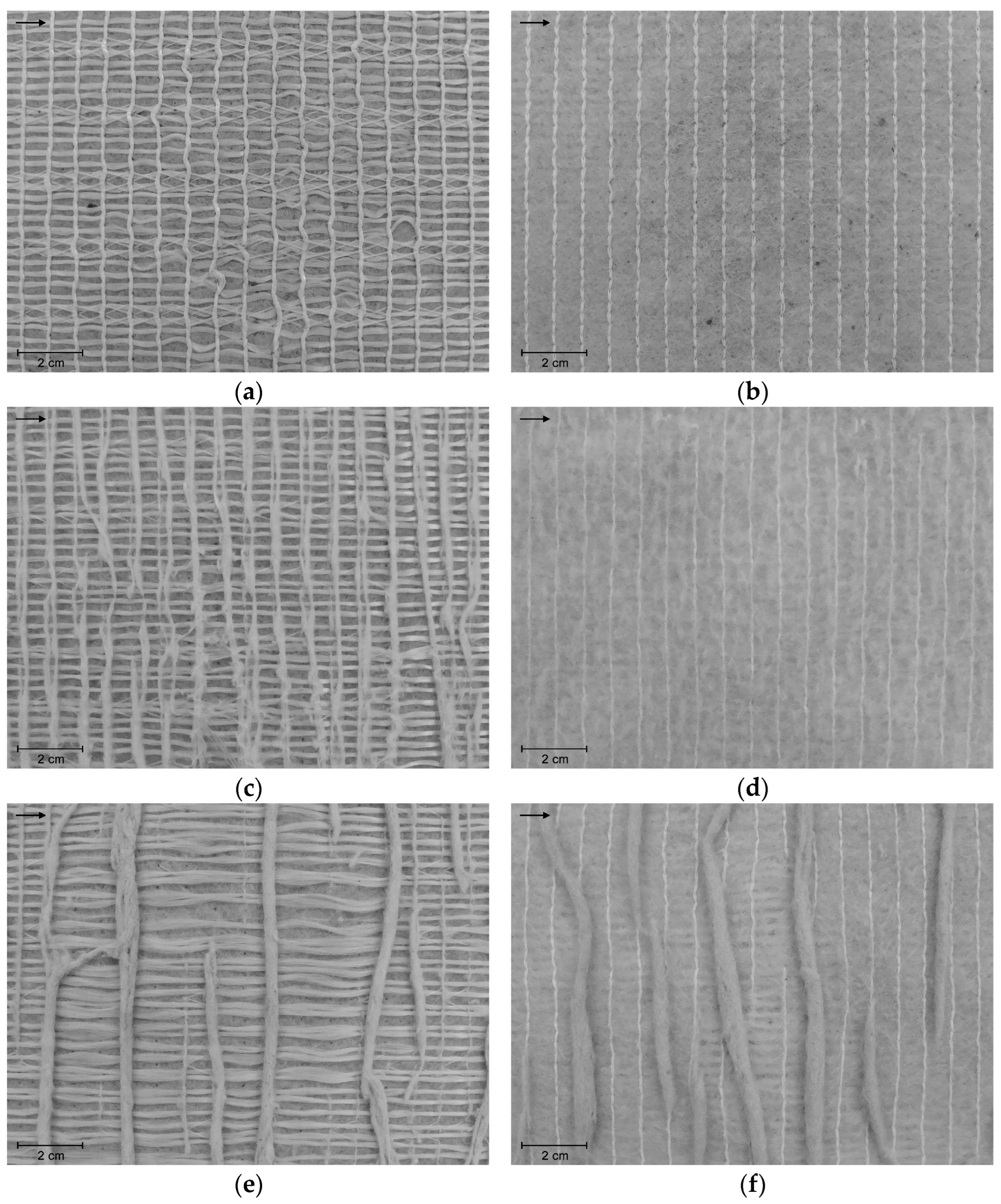
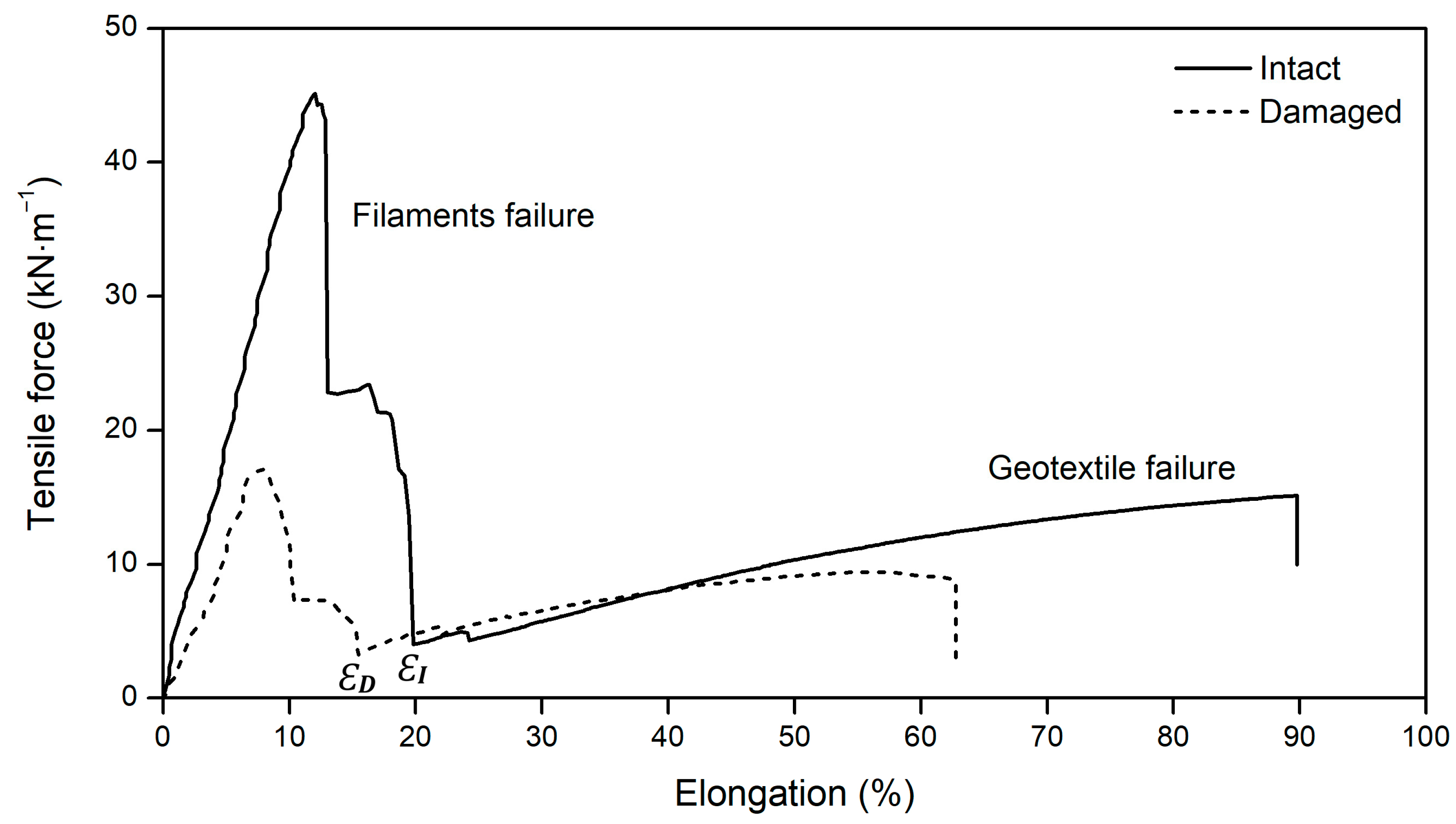
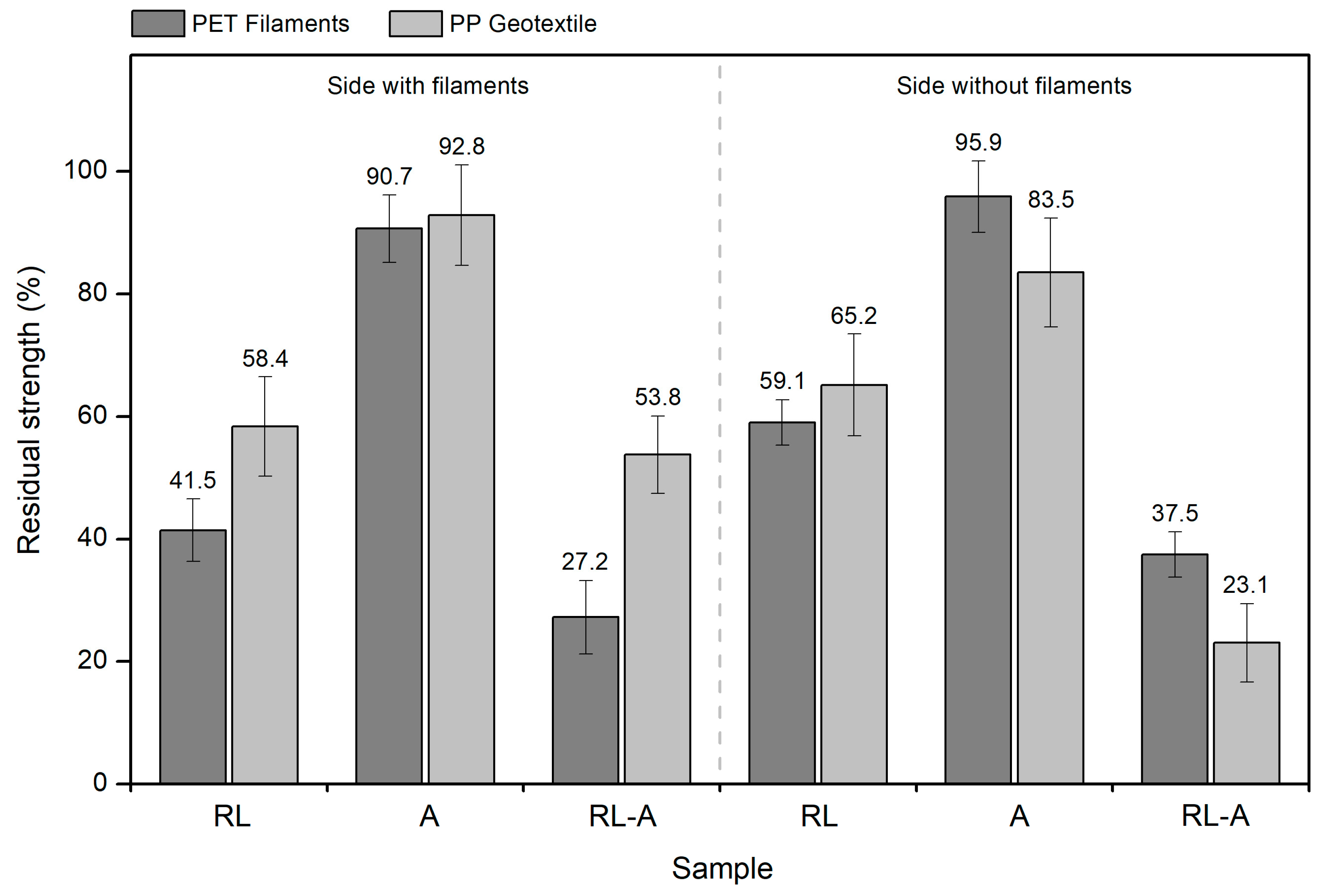
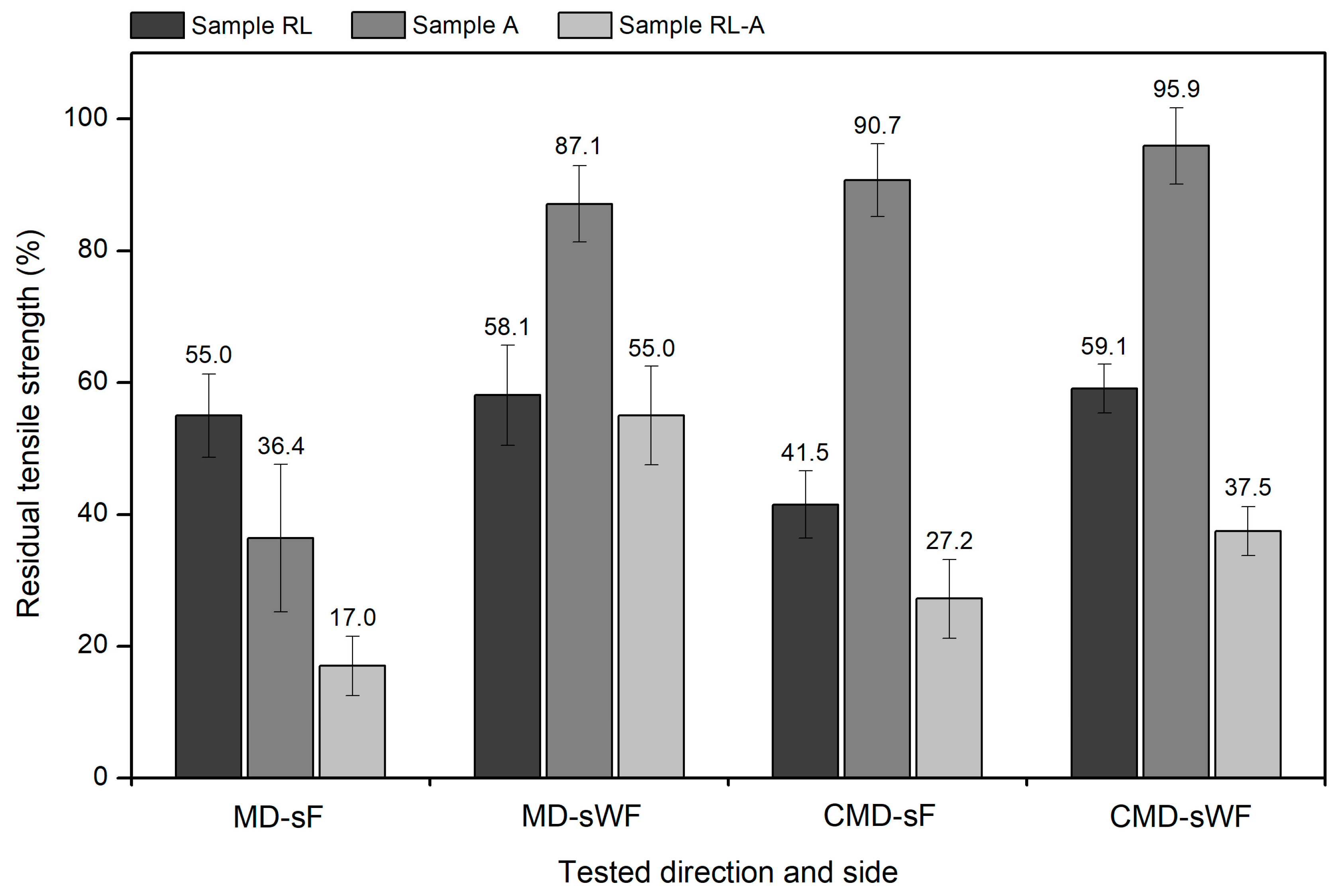
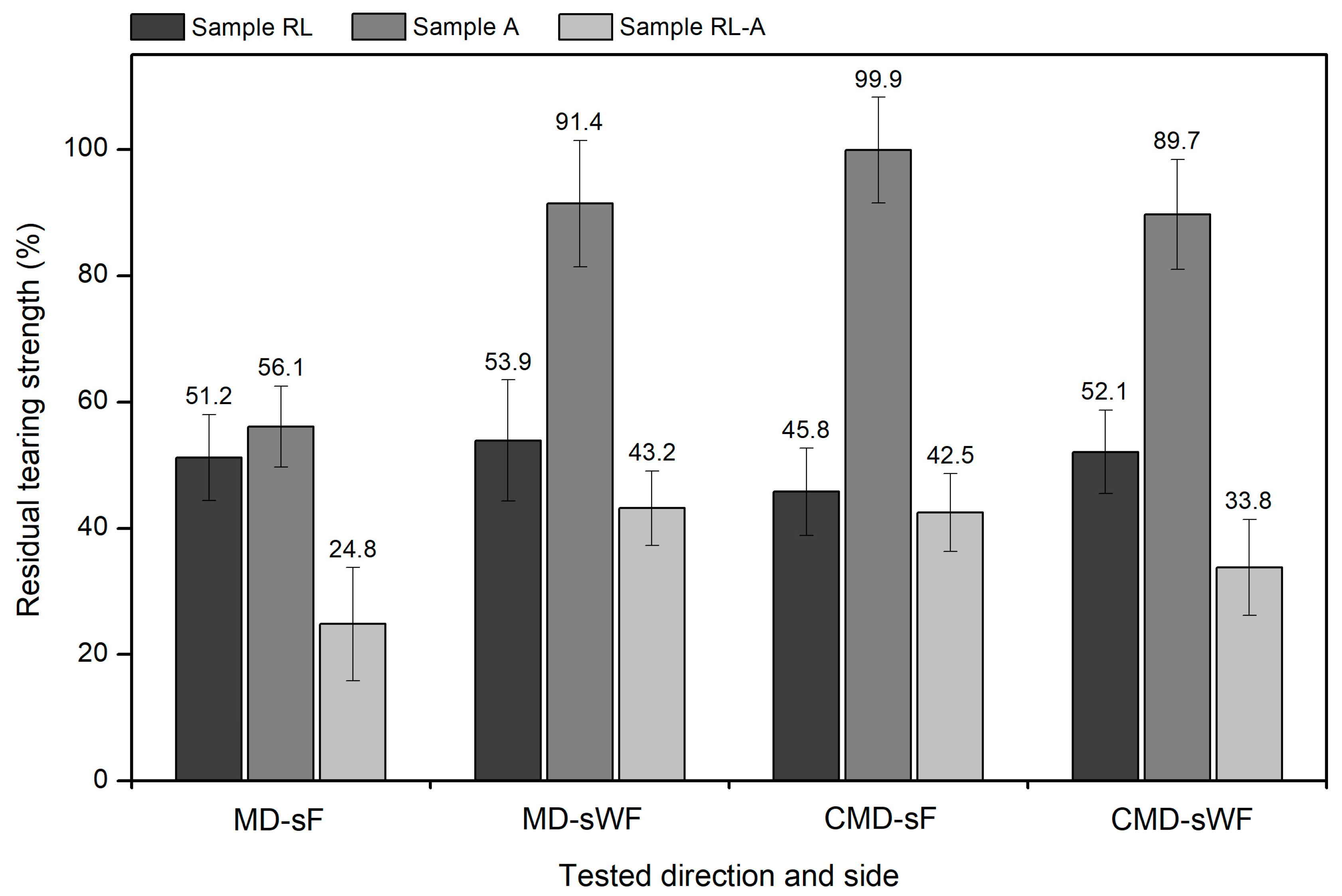
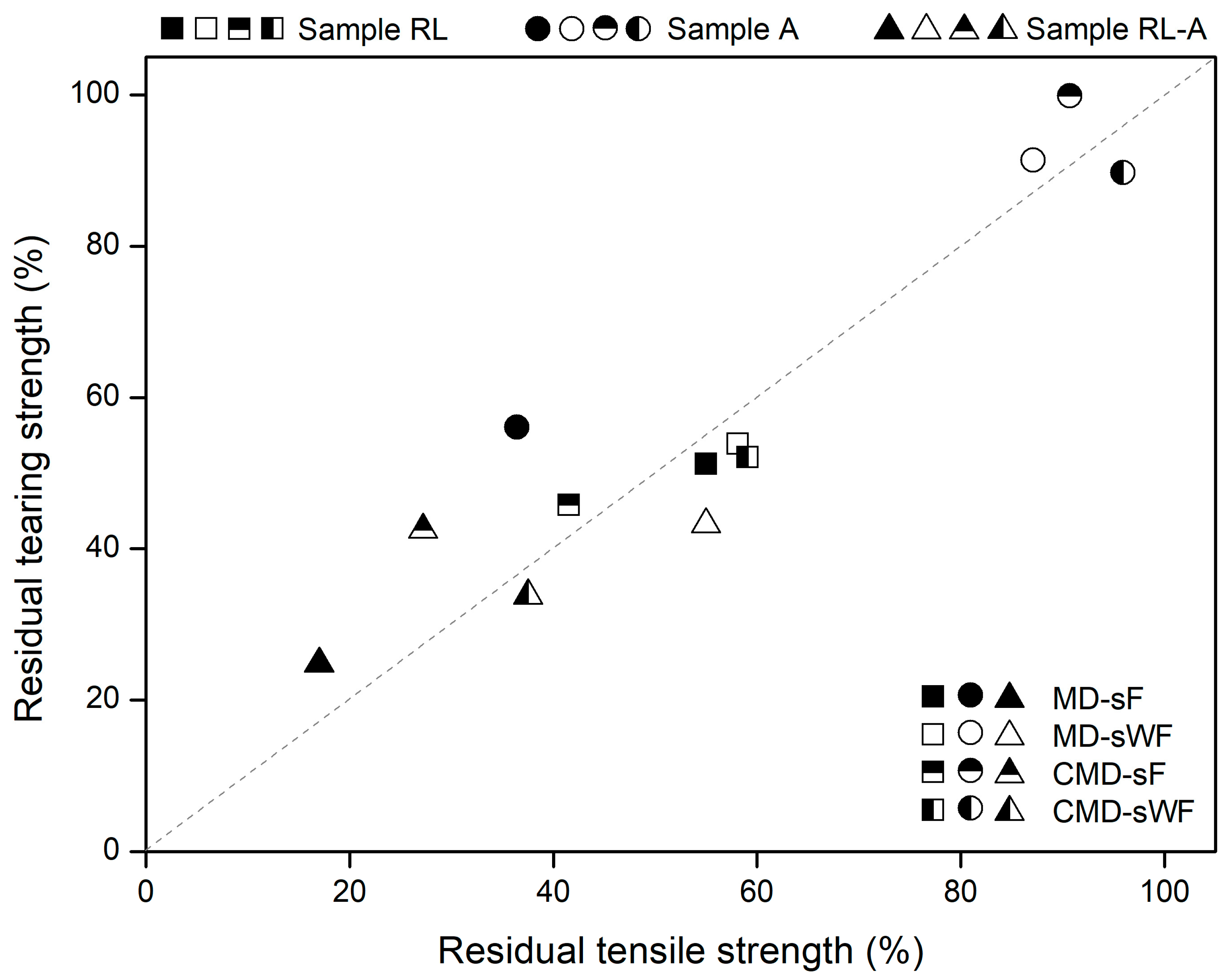
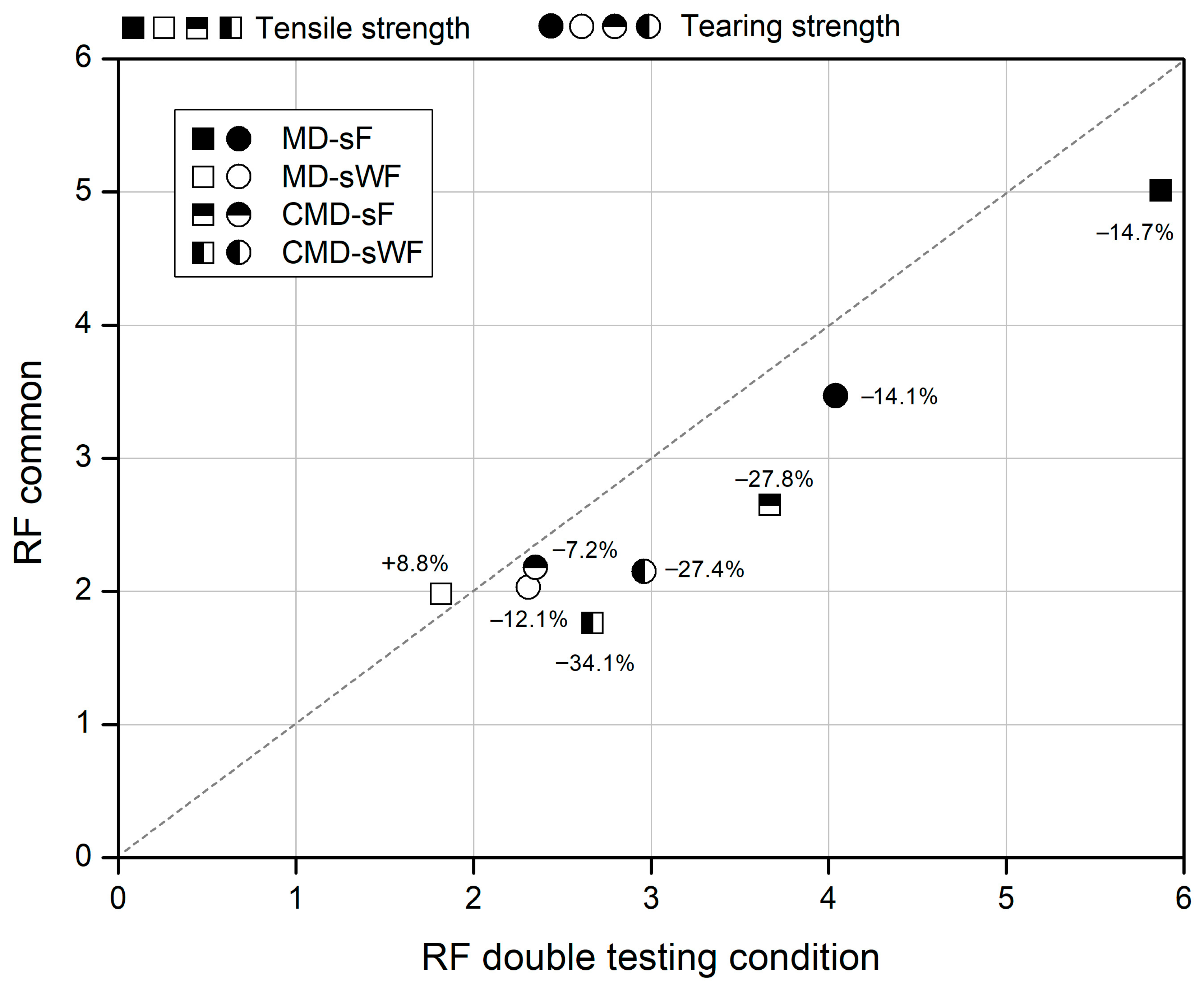
| Sample | Number of Specimens Tested | |||
|---|---|---|---|---|
| MD-sF | MD-sWF | CMD-sF | CMD-sWF | |
| Intact | 10 | 10 | 15 | 15 |
| RL | 10 | 10 | 15 | 15 |
| A | 10 | 10 | 15 | 15 |
| RL-A | 10 | 10 | 15 | 15 |
| Sample | Side | Visual Remarks |
|---|---|---|
| RL | sF | MD and CMD filaments: cuts; structural modifications (pulled filaments) |
| Geotextile: cuts in fibres; punctures; holes | ||
| Seams: mostly undamaged | ||
| sWF | MD and CMD filaments: cuts; structural modifications (pulled filaments) | |
| Geotextile: cuts in fibres; punctures; holes | ||
| Seams: mostly undamaged | ||
| A | sF | MD filaments: detached and cut; clusters of damaged filaments |
| CMD filaments: mostly undamaged | ||
| Geotextile: mostly undamaged | ||
| Seams: mostly broken | ||
| sWF | MD and CMD filaments: mostly undamaged | |
| Geotextile: fibres pulled and cut; texture change | ||
| Seams: mostly undamaged | ||
| RL-A | sF | MD filaments: detached and cut; large clusters of damaged filaments |
| CMD filaments: cuts, structural modifications (pulled filaments, loose filaments) | ||
| Geotextile: cuts in fibres, punctures, holes | ||
| Seams: mostly broken | ||
| sWF | MD and CMD filaments: cuts; structural modifications (pulled filaments) | |
| Geotextile: punctures, holes, fibres pulled and cut/detached, clusters of fibres | ||
| Seams: mostly undamaged |
| Sample | Side with Filaments | Side without Filaments | ||
|---|---|---|---|---|
| T (kN·m−1) | ƐT (%) | T (kN·m−1) | ƐT (%) | |
| Intact | 43.10 ± 1.64 | 9.4 ± 2.0 | 43.10 ± 1.64 | 9.4 ± 2.0 |
| RL | 17.87 ± 2.11 | 6.6 ± 2.1 | 25.46 ± 1.28 | 7.9 ± 1.2 |
| A | 39.08 ± 1.82 | 7.7 ± 2.7 | 41.33 ± 1.96 | 8.3 ± 2.0 |
| RL-A | 11.74 ± 2.55 | 6.2 ± 2.7 | 16.15 ± 1.49 | 7.8 ± 2.4 |
| Sample | Side with Filaments | Side without Filaments | ||
|---|---|---|---|---|
| F (kN·m−1) | ƐF (%) | F (kN·m−1) | ƐF (%) | |
| Intact | 15.65 ± 0.79 | 87.6 ± 13.0 | 15.65 ± 0.79 | 87.6 ± 13.0 |
| RL | 9.14 ± 1.18 | 49.0 ± 9.4 | 10.20 ± 1.19 | 48.8 ± 5.7 |
| A | 14.53 ± 1.04 | 77.8 ± 6.8 | 13.07 ± 1.22 | 90.0 ± 12.8 |
| RL-A | 8.42 ± 0.88 | 45.9 ± 12.0 | 3.61 ± 0.98 | 61.0 ± 20.0 |
| Sample | FT (N) | |||
|---|---|---|---|---|
| MD-sF | MD-sWF | CMD-sF | CMD-sWF | |
| Intact | 965 ± 80 | 965 ± 80 | 871 ± 57 | 871 ± 57 |
| RL | 494 ± 52 | 520 ± 82 | 399 ± 54 | 454 ± 49 |
| A | 541 ± 42 | 882 ± 62 | 870 ± 45 | 781 ± 57 |
| RL-A | 239 ± 84 | 417 ± 46 | 370 ± 49 | 294 ± 64 |
| Side | Sample | RF for T | RF for FT | |
|---|---|---|---|---|
| CMD | MD | CMD | ||
| sF | RL | 2.41 | 1.95 | 2.18 |
| A | 1.10 | 1.78 | 1.00 | |
| RL-A | 3.67 | 4.04 | 2.35 | |
| sWF | RL | 1.69 | 1.86 | 1.92 |
| A | 1.04 | 1.09 | 1.12 | |
| RL-A | 2.67 | 2.31 | 2.96 | |
Disclaimer/Publisher’s Note: The statements, opinions and data contained in all publications are solely those of the individual author(s) and contributor(s) and not of MDPI and/or the editor(s). MDPI and/or the editor(s) disclaim responsibility for any injury to people or property resulting from any ideas, methods, instructions or products referred to in the content. |
© 2023 by the authors. Licensee MDPI, Basel, Switzerland. This article is an open access article distributed under the terms and conditions of the Creative Commons Attribution (CC BY) license (https://creativecommons.org/licenses/by/4.0/).
Share and Cite
Carneiro, J.R.; Almeida, F.; Carvalho, F.; Lopes, M.d.L. Tensile and Tearing Properties of a Geocomposite Mechanically Damaged by Repeated Loading and Abrasion. Materials 2023, 16, 7047. https://doi.org/10.3390/ma16217047
Carneiro JR, Almeida F, Carvalho F, Lopes MdL. Tensile and Tearing Properties of a Geocomposite Mechanically Damaged by Repeated Loading and Abrasion. Materials. 2023; 16(21):7047. https://doi.org/10.3390/ma16217047
Chicago/Turabian StyleCarneiro, José Ricardo, Filipe Almeida, Filipa Carvalho, and Maria de Lurdes Lopes. 2023. "Tensile and Tearing Properties of a Geocomposite Mechanically Damaged by Repeated Loading and Abrasion" Materials 16, no. 21: 7047. https://doi.org/10.3390/ma16217047
APA StyleCarneiro, J. R., Almeida, F., Carvalho, F., & Lopes, M. d. L. (2023). Tensile and Tearing Properties of a Geocomposite Mechanically Damaged by Repeated Loading and Abrasion. Materials, 16(21), 7047. https://doi.org/10.3390/ma16217047






